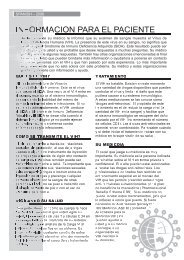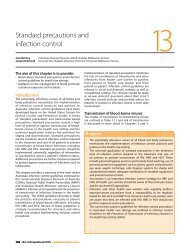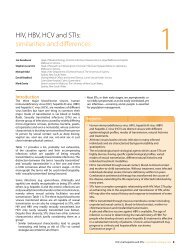B Positive – all you wanted to know about - ASHM
B Positive – all you wanted to know about - ASHM
B Positive – all you wanted to know about - ASHM
Create successful ePaper yourself
Turn your PDF publications into a flip-book with our unique Google optimized e-Paper software.
MANAGING HEPATITIS B<br />
VIRUS INFECTION IN<br />
COMPLEX SITUATIONS<br />
Benjamin Cowie Vic<strong>to</strong>rian Infectious Diseases Service, Royal Melbourne Hospital and Vic<strong>to</strong>rian Infectious<br />
Diseases Reference Labora<strong>to</strong>ry, North Melbourne, VIC.<br />
Links <strong>to</strong>: Chapter 3: Hepatitis B virus testing and interpreting test results<br />
Chapter 4: Natural his<strong>to</strong>ry of chronic hepatitis B virus infection<br />
Chapter 5: Primary prevention of hepatitis B virus infection<br />
Chapter 7: Treatment of chronic hepatitis B virus infection<br />
Chapter 8: Managing patients with advanced liver disease<br />
Chapter 9: Hepatitis B virus-related hepa<strong>to</strong>cellular carcinoma<br />
KEY POINTS<br />
there are a number of special situations in<br />
which the complexity of managing the care of<br />
a patient with hepatitis b virus (HbV) infection<br />
is increased. Primary care practitioners are<br />
optim<strong>all</strong>y placed <strong>to</strong> recognise and respond <strong>to</strong><br />
these situations, and coordinate a management<br />
plan that maximises the health and wellbeing<br />
of the patient with HbV infection.<br />
Pregnant women and HBV<br />
Worldwide, the majority of people with<br />
chronic HbV infection acquired the infection<br />
at birth or in early childhood. Given that age<br />
at infection determines the risk of progression<br />
10<br />
Facts<br />
� ninety per cent of the mother-<strong>to</strong>-child transmission of hepatitis b virus (HbV) is preventable.<br />
� several antiviral drugs used in the treatment of human immunodeficiency virus (HiV) infection are<br />
also effective against HbV.<br />
� the reactivation of HbV infection in the setting of immunosuppression can also occur in people who<br />
have a his<strong>to</strong>ry of resolved acute HbV infection.<br />
Myths<br />
� Mothers with HbV infection should not breastfeed.<br />
� children with HbV do not develop cirrhosis, hepa<strong>to</strong>cellular carcinoma (Hcc) or other manifestations<br />
of advanced liver disease.<br />
� People with HiV should not be concerned <strong>about</strong> viral hepatitis, as complications take many years <strong>to</strong><br />
develop.<br />
<strong>to</strong> chronicity (see chapter 4: natural his<strong>to</strong>ry of<br />
chronic hepatits b virus infection), with 90%<br />
of neonatal infections resulting in chronic<br />
infection, averting the vertical transmission<br />
of HbV is critical. for many women with HbV<br />
infection who are pregnant or planning<br />
pregnancy, the possibility of HbV transmission<br />
<strong>to</strong> their child is a cause of significant distress.<br />
adequate counselling and addressing the<br />
mother’s concerns are crucial, emphasising<br />
the availability of highly effective treatment <strong>to</strong><br />
prevent transmission. it is also an opportunity<br />
<strong>to</strong> assess the HbV status of other family and<br />
household members and <strong>to</strong> vaccinate <strong>all</strong> those<br />
who are susceptible.<br />
b <strong>Positive</strong> <strong>–</strong> <strong>all</strong> <strong>you</strong> <strong>wanted</strong> <strong>to</strong> <strong>know</strong> <strong>about</strong> hepatitis b: a guide for primary care providers 75






